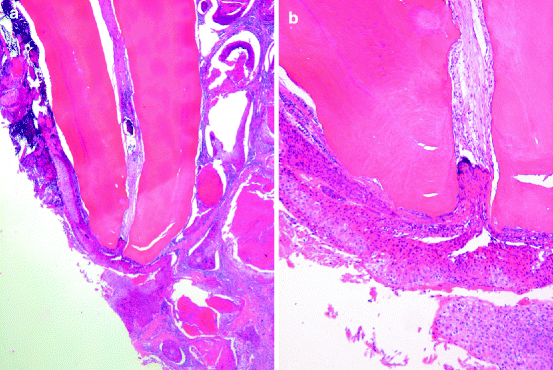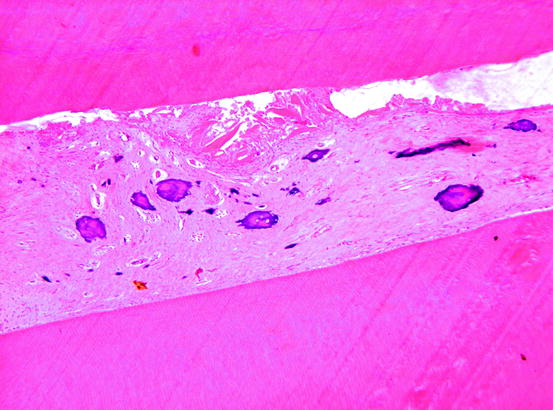(1)
Department of Pathology, Radboud University Nijmegen Medical Center, Nijmegen, The Netherlands
Abstract
Pulpal diseases may be either inflammatory or degenerative. Very rarely, jaw tumours may grow through the apical foramen into the pulp space.
Pulpal diseases may be either inflammatory or degenerative. Very rarely, jaw tumours may grow through the apical foramen into the pulp space (Fig. 8.1a, b).


Fig. 8.1
Squamous cell carcinoma invading the tooth pulp through the apical foramen shown in low (a) and higher (b) magnification
Pulp Stones, False and True (Denticles)
Denticles are calcified masses in the dental pulp. One discerns between true denticles that have tubules like dentin and false denticles that have a concentrically lamellated structure. Irrespective of being identifiable as true or false, they may lie free in the dental pulp, being connected with the wall of the pulp chamber, or lie entirely within the dentin in case of formation of excessive secondary or tertiary dentin. Depending on this topographical relationship with the tooth, they are classified as either free, attached or embedded (Fig. 8.2a, b).


Fig. 8.2
The pulp may contain calcified aggregates representing poorly structured dentin. These denticles may lie free in the pulp (a) or attached to the pulp wall (b). In (b) is also shown that they may cause subtotal pulp obliteration. As these masses do not display regularly arranged dentin tubuli, they should be classified as false denticles
In addition to calcifications in the form of denticles, the pulp may contain diffuse calcifications, occurring as metaplastic ossification along collagen fibres or blood vessels. Through merging of these calcifications with each other, large masses may form (Fig. 8.3). They however lack the inner structure and circumscribed nature shown by the true or false denticles.


Fig. 8.3
The pulp may also contain amorphous calcified deposits. These are not real denticles
Internal Resorption
In case of internal resorption, the dental pulp transforms into granulation tissue with multinucleated osteoclasts accumulating at the pulpo-dentinal border. There, they resorb the dentin, thus increasing the size of the pulp chamber [1]. Simultaneously, irregular masses of hard tissue resembling both bone and dentin may be formed haphazardly in the enlarged pulp chamber, partly onto the pulp wall but also free (Fig. 8.4a–c
Stay updated, free dental videos. Join our Telegram channel

VIDEdental - Online dental courses


